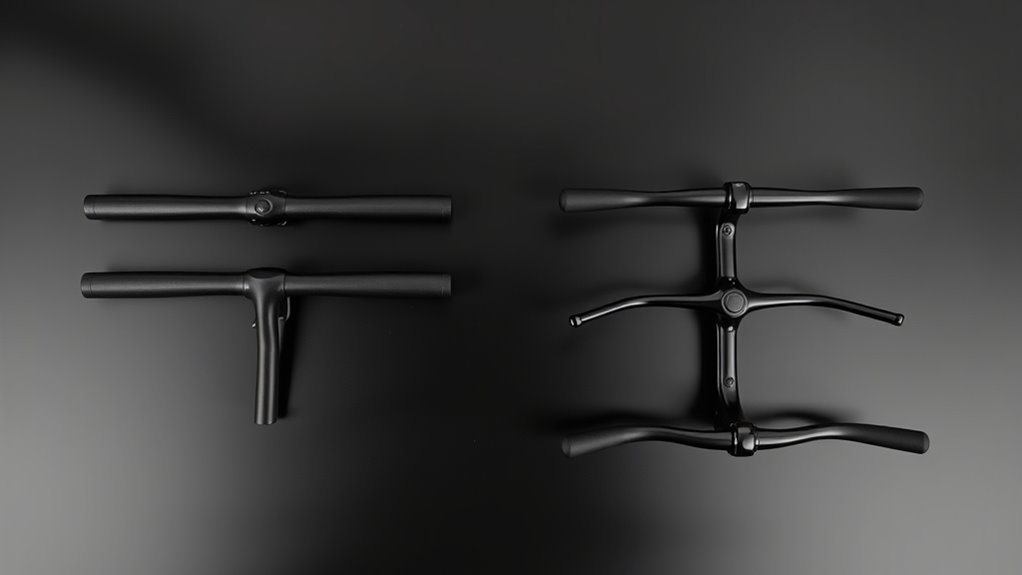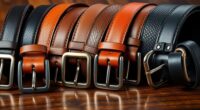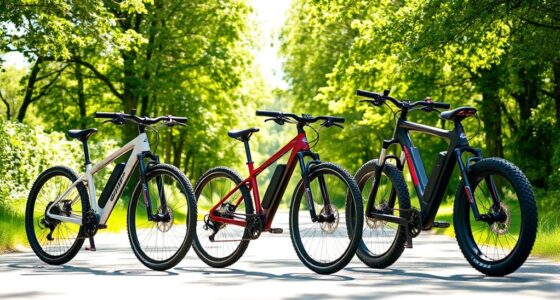Choosing between flat, riser, drop, and swept-back handlebars depends on your riding style and comfort. Flat bars are great for mountain biking and hybrids, offering quick steering and an upright position. Riser bars add a relaxed feel for rough terrains, while drop bars suit road cyclists wanting multiple hand positions and aerodynamics. Swept-back bars provide a comfortable, casual ride ideal for commuters. Exploring these options helps you find the perfect style for your bike and riding goals.
Key Takeaways
- Flat handlebars are common on mountain bikes and hybrids, offering an upright posture and easy control.
- Riser handlebars have an upward bend, providing comfort and stability on rough terrains.
- Drop handlebars are favored by road cyclists for multiple hand positions and aerodynamic efficiency.
- Swept-back handlebars curve toward the rider, enhancing comfort and a relaxed riding posture.
- The choice of handlebar type influences control, comfort, riding style, and aesthetic appeal based on terrain and goals.

Handlebar Types
Are you familiar with the different types of bicycle handlebars and how they can impact your riding experience? Choosing the right handlebar isn’t just about comfort; it’s about optimizing your control, efficiency, and even style. Each handlebar type offers unique benefits, so understanding their design and purpose can help you ride better and enjoy your bike more.
Flat handlebars are among the most common, especially for mountain bikes and hybrids. They provide an ergonomic design that allows you to maintain a natural, upright posture, reducing strain on your back and shoulders. Flat bars give you quick, direct steering, which is perfect for technical terrain or maneuvering urban streets. Their simple, clean aesthetic appeal also makes them popular among riders who prefer a minimalist look. Because of their straightforward design, flat handlebars are easy to customize with accessories, giving you a sleek, personalized appearance.
Flat handlebars are popular for their ergonomic design, minimalist style, and easy customization.
Riser handlebars are essentially a variation of flat bars but feature a slight upward bend. This ergonomic adjustment enhances comfort by allowing a more relaxed arm position, which can decrease fatigue on longer rides. Riser bars are especially favored in mountain biking for their superior control and stability on rough terrain. Their design not only improves functionality but also adds a distinctive aesthetic appeal, often giving your bike a more aggressive or utilitarian look. The raised design helps you maintain better leverage, making sharp turns and quick maneuvers feel more natural and less tiring. Additionally, the ergonomic benefits of riser bars can be especially helpful for riders with joint or wrist issues.
Drop handlebars are the classic choice for road cyclists. They provide multiple hand positions, which is vital during long-distance rides. The ergonomic design of drop bars allows you to switch between an upright position and a more aerodynamic, aggressive stance. This versatility can boost your performance and reduce fatigue by shifting your posture as needed. Visually, drop handlebars lend a sleek, racing-inspired aesthetic appeal, emphasizing speed and agility. Their contoured shape carefully balances comfort and aerodynamics, making them ideal if you’re aiming for speed and efficiency on paved surfaces.
Swept-back handlebars, often seen on commuter bikes and cruisers, emphasize comfort and relaxed riding. Their design curves back toward you, allowing your hands to rest in a natural position, which minimizes wrist strain. The ergonomic design of swept-back bars encourages an upright posture, reducing pressure on your neck and back—crucial for leisurely rides or daily commuting. They also contribute to a laid-back aesthetic appeal, giving your bike a more casual and inviting look. These handlebars are perfect if you prioritize comfort and style over aggressive riding. Overall, choosing the right handlebar type based on your riding style and ergonomic needs can greatly enhance your cycling experience.
Frequently Asked Questions
Which Handlebar Type Is Best for Long-Distance Touring?
For long-distance touring, you should choose handlebars that offer ergonomic benefits and comfort. Riser bars are ideal because they provide an upright, natural riding position, reducing strain on your back and wrists. They also look sleek and modern, fitting well with various bike styles. With riser bars, you’ll enjoy better control and less fatigue during extended rides, making your touring experience more enjoyable and less tiring.
How Do Handlebar Types Affect Bike Handling and Control?
Handlebar types directly influence your bike handling and control by affecting ergonomics considerations and aerodynamic benefits. Flat bars give you a stable, upright position, making steering easier. Drop bars offer better aerodynamics for speed, but require more precise control. Riser and swept-back handlebars provide comfort and control, especially on longer rides. Your choice impacts maneuverability, comfort, and aerodynamics, so select based on your riding style and terrain to optimize handling and control.
Can I Switch Handlebar Types on My Existing Bike?
Switching handlebar types is like giving your bike a fresh pair of shoes—you can definitely do it, but consider handlebar customization and ergonomic considerations first. You’ll need to verify your bike fits the new handlebar’s dimensions and that it won’t interfere with cables or brakes. If you’re comfortable with basic bike maintenance, you can swap them yourself; otherwise, a professional can help ensure a safe, comfortable ride.
Are Certain Handlebar Styles Better for Specific Cycling Disciplines?
Yes, certain handlebar styles suit specific cycling disciplines better. For ergonomic comfort during long rides, riser or swept-back bars reduce strain, making them ideal for commuting or touring. Drop bars enhance aerodynamics for racing or fast riding, while flat bars offer a straightforward, versatile look for mountain biking or urban cycling. Choose a style that balances comfort and aesthetic appeal based on your riding style and terrain.
What Are the Maintenance Differences Between Handlebar Types?
Did you know that handlebar maintenance accounts for about 15% of overall bike upkeep? You’ll find that maintenance differences mainly involve handlebar material, cleaning, and lubrication. For example, carbon handlebars require gentle cleaning and specific lubricants, while aluminum ones are more forgiving. Riser bars, often with more crevices, might need extra attention. Regularly check for wear, clean with mild soap, and lubricate moving parts to keep your handlebars in top shape.
Conclusion
Choosing the right handlebar depends on your riding style and comfort. Whether you prefer the sleekness of drop bars or the relaxed grip of swept-back handlebars, each type offers unique benefits. Remember, “the right tool for the right job” makes all the difference. By selecting the handlebar that suits your needs, you’ll enjoy a more comfortable and confident ride. Trust your instincts, and find what feels best — your bike, your ride, your way.









